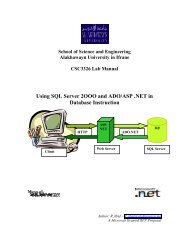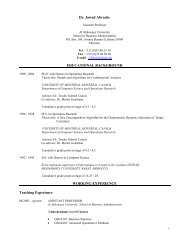Leadership and Values in Language Education - Al Akhawayn ...
Leadership and Values in Language Education - Al Akhawayn ...
Leadership and Values in Language Education - Al Akhawayn ...
- No tags were found...
Create successful ePaper yourself
Turn your PDF publications into a flip-book with our unique Google optimized e-Paper software.
49Proceed<strong>in</strong>gs of the 27 th MATE Annual Conferenceis crucial <strong>in</strong> improv<strong>in</strong>g schools <strong>and</strong> ensur<strong>in</strong>g their success. Collegiality entailscont<strong>in</strong>uous collaboration of teachers’ efforts as well as their co-operation <strong>and</strong>network<strong>in</strong>g. Mitchell <strong>and</strong> Sackney (2000) have found that school improvement ismore likely to take place when teachers have confidence <strong>in</strong> themselves, <strong>in</strong> theability of their colleagues to create change, <strong>and</strong> <strong>in</strong> the ability of their schools toenhance their professional development (cited <strong>in</strong> Harris <strong>and</strong> Muijs, 2002).In order to achieve these benefits, it is thus necessary to view teachers as partners<strong>in</strong> the educational process. Partnership can be established by “stretch<strong>in</strong>g”leadership, to use Spillane <strong>and</strong> Sherer’s (2004) term, across teachers. Some ofthe areas <strong>in</strong> which leadership can be stretched, henceforth enabl<strong>in</strong>g teachers totake up their potential as leaders, are as follows:• Evaluation of colleagues’ teach<strong>in</strong>g performance• Selection of textbooks <strong>and</strong> <strong>in</strong>structional materials• Recruitment of new staff, teachers, <strong>and</strong> adm<strong>in</strong>istrators• Curriculum development <strong>and</strong> action research• School policies• Coord<strong>in</strong>ation of programs• Professional development• Coach<strong>in</strong>g <strong>and</strong> mentor<strong>in</strong>g students3. Team power—Distributed <strong>Leadership</strong> at WorkIn this section, I provide a concrete case of how distributed leadership is put towork <strong>in</strong> an education center <strong>in</strong> Morocco. This is done with a view to help<strong>in</strong>greaders who are will<strong>in</strong>g to take action see how distributed leadership can create ademocratic atmosphere that promotes students’ learn<strong>in</strong>g <strong>and</strong> teachers’ selfesteem.I will use pseudonyms when referr<strong>in</strong>g to teachers <strong>in</strong> order not to disclosetheir identity. On average, teachers <strong>in</strong> this center teach two courses, with twosections each, for a total of twelve hours per week. Three aspects of distributedleadership are discussed below: collaboration, collegiality, <strong>and</strong> <strong>in</strong>volvement <strong>in</strong>committees.Collaboration: <strong>Al</strong>though the center under scrut<strong>in</strong>y is run by a director, Sabr<strong>in</strong>a,she is not the one who selects the materials for the course. At the beg<strong>in</strong>n<strong>in</strong>g ofeach semester, one coord<strong>in</strong>ator is appo<strong>in</strong>ted per course. The coord<strong>in</strong>ator usuallyvolunteers to coord<strong>in</strong>ate a course <strong>and</strong> if nobody shows <strong>in</strong>itiative, the directorappo<strong>in</strong>ts one. In the worst case scenario, when nobody is will<strong>in</strong>g to coord<strong>in</strong>ate a
















